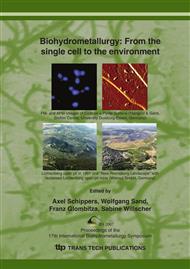p.531
p.535
p.539
p.543
p.547
p.551
p.557
p.561
p.565
Isolation and Molecular Characterization of Sulfate Reducing Bacteria in a Brazilian Acid Mine Drainage
Abstract:
Acid mine drainage (AMD) waters are highly acidic (pH < 4), contain high concentrations of sulfate and dissolved metals, and are very toxic to many living organisms. The development of technologies to treat sulfate contaminated wastewaters by using sulfate-reducing bacteria (SRB) has produced a cost-effective route to treat AMD. Notwithstanding, the SRB sensitivity to acid limits their use in AMD remediation. In the current study, acidophilic strains of SRB were isolated from an AMD followed by their molecular characterization. One SRB-culture was able to grow at pH 4.5 in Postgate C modified medium containing ethanol as carbon source, indicating that such bacterium has the potential for the bioremediation of acidic waters. Following, the strains were characterized by molecular biology techniques. The characterization was done by PCR amplification, cloning and sequencing of the genes coding for parts of the alpha and beta subunits of dissimilatory sulfite reductase (dsrAB) and hydrogenase (hyd), which encode key enzymes of the SRB energy metabolism. Phylogenetic analysis suggested a line of SRB descent from the delta-Proteobacteria among the strains identified as Desulfovibrio fructosovorans.
Info:
Periodical:
Pages:
547-550
Citation:
Online since:
July 2007
Authors:
Price:
Сopyright:
© 2007 Trans Tech Publications Ltd. All Rights Reserved
Share:
Citation:


